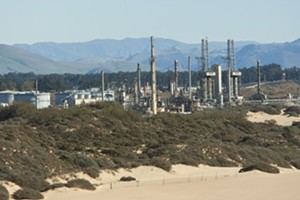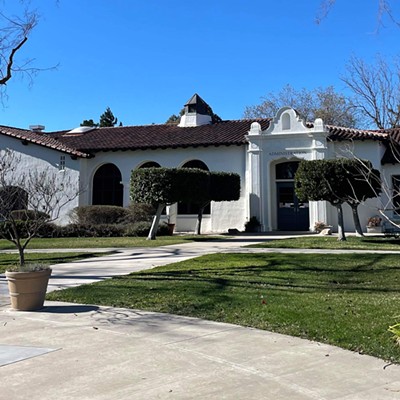Oil giant Phillips 66’s San Francisco Refinery in Contra Costa County no longer processes crude oil—a change that’s impacted the Central Coast.
Aimee Henry, the company’s communications director, told the Sun that the transformation aligned with the state’s environmental goals and market conditions.
“The Rodeo Renewable Energy Complex [formerly the San Francisco Refinery] supports demand for renewable diesel and sustainable aviation fuel, which reduce the lifecycle carbon intensity of these transportation fuels,” she said. “Production of renewable fuels at the converted facility reduces both criteria pollutant emissions and lifecycle carbon emissions.”
The $1.3 billion switch resulted in the shuttering of the Santa Maria Refinery on the Nipomo Mesa in January 2023. The production site of semi-refined liquid petroleum, carbon, and granular sulfur since 1955 held pipelines that transported those partly processed products to the Bay Area refinery for further refinement into finished petroleum products.
Not needing the Santa Maria Refinery any longer, Phillips 66 applied for a SLO County development plan and coastal development permit approval in August 2022 to demolish the facility. It currently rests on 218 acres of fenced land within 1,642 acres of property owned by Phillips 66.
“The proposed project consists of demolition of most of the aboveground refinery structures,” said Susan Strachan, power plant decommissioning manager, via email. “Some structures would remain (surface hardscape, rail spurs, truck scale, wastewater outfall pipeline) for potential future use. The proposed project also entails removal of belowground features where soil remediation is required.”
The county’s acceptance of Phillips 66’s demolition application in March 2023 launched an environmental review process as required by the California Environmental Quality Act (CEQA). It resulted in a 714-page draft environmental impact report released on March 22.
The public review period will end on May 6.
Community members can email their views to [email protected] or mail written responses to Strachan with the SLO County Department of Planning and Building at 976 Osos St., Room 300, SLO, CA 93408. Find the complete draft report by visiting the SLO County Department of Planning and Building’s home page.
In 2013, Phillips 66 applied for a SLO County permit to install an extension of its rail spur, which would have allowed it to import oil to the Santa Maria Refinery by train. Critics of the proposed project raised public safety concerns about the oil-hauling trains, worrying that they could derail, crash, and explode. The Planning Commission denied the project in 2016. The SLO County Board of Supervisors upheld that rejection on appeal in 2017, prompting Phillips 66 to sue. The years-long fight culminated in a 2017 settlement between several environmental groups and Phillips 66 where the latter agreed to SLO County’s denial of the project, and both parties called to dismiss the lawsuit with prejudice.
Strachan told the Sun that the Santa Maria Refinery’s closure in 2023 created some immediate changes for the surrounding area. Phillips 66’s decommissioning of the facility began a cleanup of large storage tanks under existing permits, for one.
“With the shutdown, all air emissions and greenhouse gas emissions ceased,” she said. “There was also a reduction in truck and rail transportation and noise.”
But the refinery’s demolition might result in two “significant and unavoidable” impacts for the neighboring regions, according to the draft report. Short-term construction activities on the site would increase the emission of particulate matter on the Nipomo Mesa that’s already classified as “Level of Severity III” for air quality by the county.
“Although the project would emit particulate matter levels below the San Luis Obispo County Air Pollution Control District … thresholds, it would still generate a ‘net increase’ in particulate matter on the Mesa and therefore be in conflict with land use policy … and potentially contribute to existing health impacts from particulate matter on the Mesa,” the draft report read.
It added that eventual refinery demolition is considered beneficial because it would result in a reduction of long-term particulate matter emission.
The second possible impact affects black abalone—mollusks found in intertidal waters along the coast that are on the federal endangered species list. The black abalone would be affected if demolition authorities pick the option to remove offshore facilities, specifically the wastewater outfall pipeline that extends roughly 2,000 feet offshore.
“The outfall pipeline is located in designated black abalone habitat, so if the outfall pipeline were removed, there could be impacts to the species,” Strachan said.
Phillips 66 leases the outfall pipeline from the State Lands Commission. The company isn’t proposing to remove the pipeline, but CEQA required the draft report to include that option as an alternative to full demolition. The environmentally superior alternative is Phillips 66’s proposed complete demolition because it has the lowest severity of potential particulate impacts, Strachan added.
Plans for the refinery land remain unknown.
“Their features on-site could be attractive to future users, like the rail spur, truck scale, the PG&E [Pacific Gas and Electric Company] substation bringing in power, and the outfall line out to the ocean,” Strachan said.















